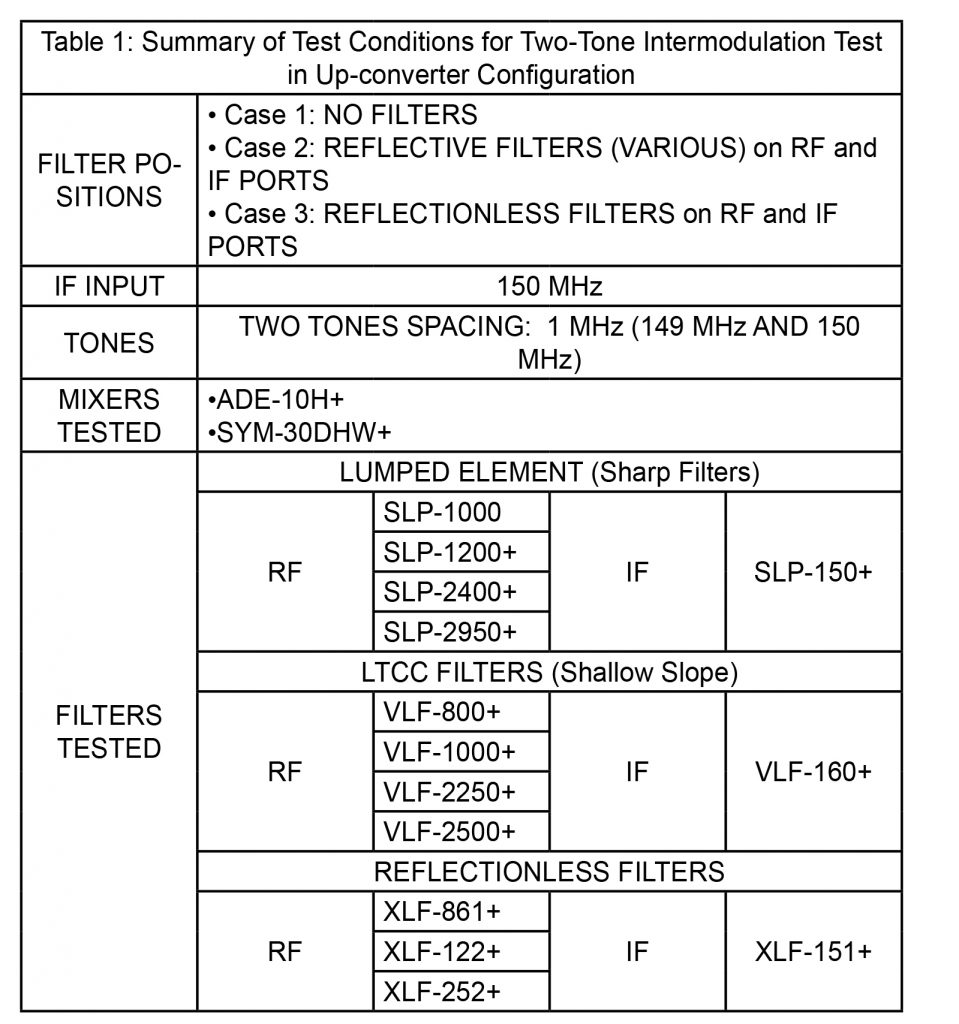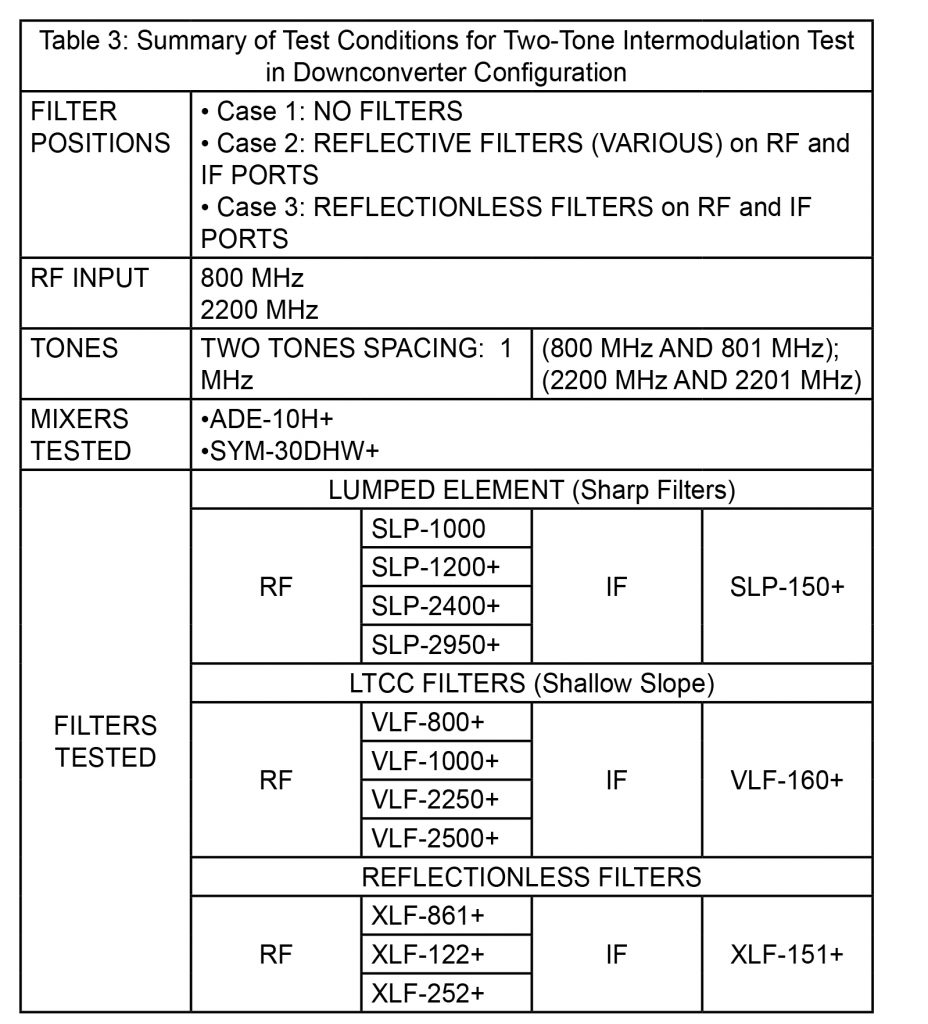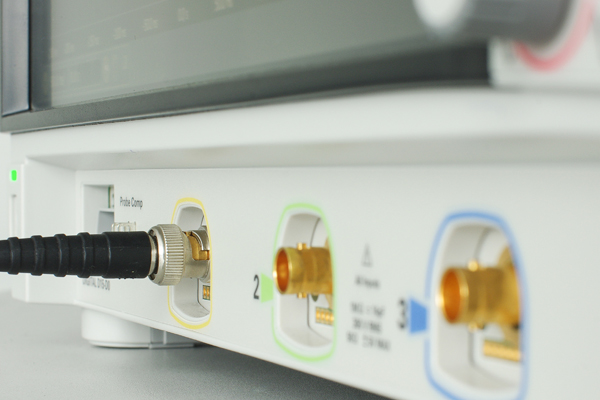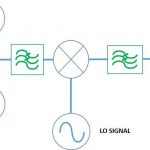Since the market release of Mini-Circuits’ X-Series reflectionless filters, much testing has been conducted to evaluatethe benefits of these revolutionary products in comparison to conventional filters. While conventional filters are fully reflective in the stopband, reflectionless filters use a novel, patented filter topology to absorb and terminate stopband signals internally, avoiding many known systemic problems caused by reflections in the signal chain. This new capability makes reflectionless filters suitable for a variety of applications beyond those typically incorporating conventional filters. One of the most prevalent and practical of these applications is filtering at mixer inputs and outputs.
Previous testing, which Mini-Circuits has published, established that reflectionless filters virtually eliminate signal reflections between the filter and the mixer output as compared to conventional filters.The expected effect of this reduction is an overall improvement is system linearity and dynamic range, but this was inferred in previous reports.
This article will present new test results demonstrating overall improvement in system IP3 when reflectionless filters are used on mixer inputs and outputs in both downconverter and upconverter configurations in comparison to conventional lumped element filters and LTCC filters. The results also expand on previous comparisons by testing numerous mixer-filter combinations and showing consistent performance improvement when reflectionless filters are used.
- Figure 1: Up-conversion test setup
- Figure 2. Top-level schematic diagram of the receiving circuit
Up-Conversion Test Setup
Two-tone intermodulation tests were performed in up-converter configuration using diode based mixers with a variety of filters on the IF input and RF output ports for comparison. The test was also performed without filters to provide a reference.Third order intermodulation measurements were made withIF input of 150 MHz and two-tone spacing of 1 MHz, and RF outputs of 800 MHz and 2200 MHz. The test setup is illustrated in Figure 1, and the test conditions are summarized in Table 1.
Each of the two mixers was tested with no filters, reflective filters (lumped element and LTCC), and reflectionless filters at the IF input and RF output ports. Low and high third order intermodulation frequencies were measured at the RF output for all cases and compared. Summary results are presented in Table 2. For brevity sake, results are shown here only for RF output of 800 MHz. Results for RF output of 2200 MHz are comparable and are available by request from Mini-Circuits.
Notice that in all cases where reflective filters were used, the filters contribute to a significant increase in thirdorder intermodulation product (IM 3) relative to the IM3 of the mixer when no filters are used. When reflectionless filters are used, however, measured IM 3 is nearly equal to or less than that of the mixer alone. These results therefore demonstrate that using reflectionless filters in the up-conversion circuit achieves an improvement in third order intermodulation performance ranging from about 5 dB to 18 dB relative to performance when conventional filters are used in the same circuit.



Down-Conversion Test Setup
Two-tone intermodulation tests were performed in downconverter configuration as shown in Figure 2. As in the up-conversion setup, different mixer-filter combinations were tested to compare reflectionless filters with various conventional filters. Mixers were also tested with no filters for reference. Third order intermodulation measurements were made for RF inputs of 800MHz and 2200 MHz with two-tone spacing of 1 MHz, and IF output of 150 MHz. The test setup is illustrated in Figure 2 and the test conditions are summarized in Table 3.
Low and high third order intermodulation frequencies were measured at IF output for all cases and compared. Summary results are presented in Table 4. Again, for brevity, only measurements for RF input of 800 MHz are shown here, but RF input of 2200 MHz produced similar results.
Again we see that reflectionless filters achieve a reduction of IM 3 levels when compared to conventional filters in the same circuit. Third order intermodulation performance with reflectionless filters on the mixer RF input and IF output is nearly equal to or slightly better than that of the mixer alone with no filters. This represents an improvement over traditional filters in the range of 5.5 to 12 dB.
Conclusion
Maximizing linearity and dynamic range has always been a goal in RF transceiver design. The IP3 of the mixer itself is one obvious factor limiting system performance, but even the best mixers produce intermodulation products at some level which can interact with neighboring elements in the RF chain. Since these neighboring elements in real-world systems are often filters, out-of-band signals are fully reflected back into the mixer where they produce a secondary set of spurious signals, which additionally limit the dynamic range of the system.
This has been a longstanding problem in RF system design, against which designers were more or less helpless until recently. Various techniques have been employed to compensate forthe adverse effects of stopband reflections (inserting attenuators or isolation amplifiers around the mixer, for example), but these solutions still degrade system SNR and dynamic range, which becomes self-defeating.
The results presented in this article demonstrate how reflectionless filters may be used with mixers in up-converter and down-converter configuration to absorb those out-of-band signals within the filter circuit itself. In comparison to conventional filters in the same circuit, reflectionless filters achievesignificant reduction of third order intermodulation products, which corresponds to proportional improvement in system dynamic range.
Mini-Circuits offers a wide range of reflectionless filters from stock in tiny QFN packages and bare die form, including low pass, band pass and high pass models with passbands from DC to 30 GHz. These patented products give designers a new tool to achieveperformance improvements similar to those presented here in their own systems.









